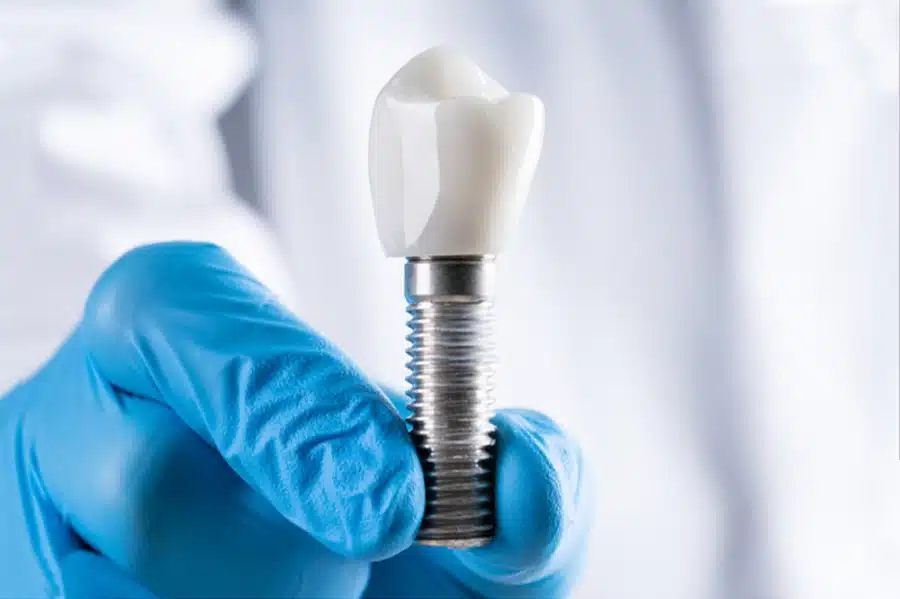As someone who wants to restore their missing teeth permanently, dental implants might interest you. These replacements mimic the natural look and function of teeth, but proper jawbone support is required.
Complications can arise from insufficient density leading to implant failure, which is where bone grafting takes a crucial role in ensuring success.
Understanding Dental Implants
If you’re considering bone grafting, it’s crucial first to grasp the basics of dental implants. A dental implant is a tiny titanium post that replaces the lost tooth root and is placed into your jawbone through surgery.
Eventually, this post bonds with the surrounding bone, creating a sturdy support for an artificial tooth or crown. By choosing dental implants over standard teeth replacement methods, one can relish their benefits: strength, better chewing capabilities, and preservation of the facial structure.
The Need for Bone Grafting
Sometimes, people may not have sufficient bone in their jaw to hold a dental implant. This could happen because of several reasons like tooth loss, periodontal disease, injury, or even natural bone resorption as one ages. However, it is essential that the implanted teeth are well-anchored in solid bone structures for longevity and stability. To resolve this issue and ensure successful implant integration, our Tijuana dentists often recommend a process called ‘bone grafting.’
What is Bone Grafting?
Bone grafting is a surgical technique that involves adding bone or bone-like materials to the jaw to improve bone volume and density. The grafting material is a structure for the patient’s natural bone to repair and grow.
Bone can be sourced from the individual (autograft), donated tissue (allograft), animal origin (xenograft), or artificial sources. The preferred choice largely depends on the person’s situation and the dentist’s recommendation.
Types of Bone Grafts
Autografts
In my experience, I’ve found that Autografts use bone harvested from another part of the patient’s own body, like the chin, hip, or shin. This type of graft presents a significant advantage as the patient’s body is less likely to reject its tissue. In addition, successful integration is more probable when using this method.
Allografts
When a patient needs bone for a surgical procedure, doctors may use either their bone or take it from a donor. This second option is called an allograft. Donor bones used in allografts go through intense sterilization processes to remove any potential disease transmission risks. Allografts are common and can be an alternative source of bone for patients who cannot provide enough of their own.
Xenografts
When a patient’s bone is damaged and cannot heal properly, Xenografts provide an alternative solution. Animal bone material, typically from cows or pigs, is processed to eliminate infection risk or immune response. This animal bone acts as a framework for the patient’s new bone growth. Over time, the graft will be replaced by the newly formed bone in the patient’s body.
Synthetic Bone Grafts
When natural bone is damaged or missing, modern medicine offers a solution with synthetic bone grafts. These innovative materials are engineered to match the structure and properties of natural bones while being biocompatible. Synthetic grafts prove to be reliable when using autografts, allografts, and xenografts is not feasible. They guarantee stable groundwork for new bone formation.

The Bone Grafting Procedure
As your dentist, let me explain the bone grafting procedure that usually precedes a dental implant surgery. Firstly, I will make a small incision in the gum tissue to expose the underlying jawbone. Next, I’ll place specialized material carefully into the targeted area and secure it with screws or let it integrate naturally.
Sometimes, I use a membrane to cover and protect the graft while healing occurs. Finally, I suture the incision closed, allowing for natural healing to begin.
Benefits of Bone Grafting for Dental Implants
Bone grafting offers several benefits for dental implant patients:
If you need a sturdy base for dental implants, bone grafting can help by either enhancing the existing bone or filling in any missing areas. This process increases bone volume and ensures a solid foundation that allows for successful implant placement.
When there is enough bone support, the chances of successful implant integration increase considerably, which leads to better long-term outcomes in terms of implant success rate.
Facial structure preservation is crucial as jawbone loss can make the face appear aged and sunken. By opting for bone grafting, you retain your facial features’ natural contours while preventing further deterioration.
Bone grafting is expanding treatment options for dental implants to people who were earlier rejected due to weak bone density. This creates more opportunities for individuals to improve their dental health and gain a brighter smile with ease.
When it comes to dental implants, a strong foundation is everything. With healthy bone support, not only do you achieve function restoration but also aesthetics.
Risks and Complications
As a surgical procedure, bone grafting poses potential risks and complications such as infection, bleeding, graft failure, nerve damage, and sinus complications. However, with the help of experienced professionals who plan well along with diligent post-operative care to minimize risks.

Recovery and Healing Process
After a bone grafting procedure, the patient’s body gradually replaces the graft material with their bone tissue. This process usually takes several months, during which the patient should adhere to specific post-operative recommendations. The guidelines include maintaining good oral hygiene and avoiding activities that could hinder proper healing.
Success Rate of Bone Grafting for Dental Implants
I’ve found the success rate of bone grafting for dental implants to be high. The dental implant benefits from the framework provided by the graft, allowing for effective integration and support.
Additionally, several factors affect its success, such as oral hygiene, overall health of the patient, following post-operative instructions, and the experience of the performing dental professional.
Alternatives to Bone Grafting
As a qualified dentist, I know that bone grafting is a common dental technique. However, if you are not eligible for this procedure, there are other options available, such as mini dental implants, zygomatic implants, or implant-supported dentures.
To determine the most effective solution tailored to your circumstances, it’s crucial to consult with a highly trained dental professional or oral surgeon.


